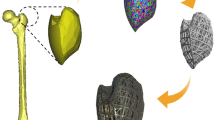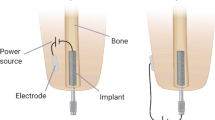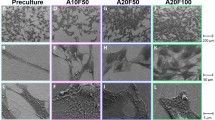Abstract
The effect of small direct current (∼8μA) upon the tensile strength of the interfacial union between porous metal and polymer implants (100–200 μm diam pores) and bone was studied in the femur of dogs.
The present results show that the electrical stimulation accelerates the rate of bony tissue growth into pores of the implants regardless of the nature of the materials tested. It is particularly exciting to find that the porous metal can be used as an electrode as well as an implant. This implies that an ordinary prosthesis made of metal can be made porous and the fixation time period can be shortened by the electrical stimulation. This has an enormous potential for all the direct fixation prostheses for rapid achievement of fixation.
Similar content being viewed by others
References
Black, J. and C.T. Brighton. Mechanisms of stimulation of osteogenesis by D.C. current. Presented at the Conference on Electric and Magnetic Control of Musculoskeletal Growth and Repair. Univ. of Pennsylvania: Philadelphia, PA, Sept. 18–20, 1978.
Brighton, C.T., Z.B. Friedenberg, L.M. Zemsky, and P.R. Pollis. Direct-current stimulation of non-union and congenital pseudoarthrosis.J. Bone J. Surg. 57A:368–377, 1975.
Currey, J.D., A.H. Burstein, and D.T. Reilly. The effect of stress concentrations in bone. 5th Annual Biomaterials Symposium, Session 4. Clemson University: Clemson, SC, April 1973.
Friedenberg, Z.B., B.I. Smolenski, B.W. Pearl, and C.T. Brighton. Bone reaction to varying amounts of direct currents.Surg. Gynecol. Obstet. 131:894–899, 1970.
Galante, J. and W. Rostoker. Fiber metal composites in the fixation of skeletal prosthesis.J. Biomed. Mater. Res. Symp. 7(4):43–61, 1973.
Hassler, C.R., E.F. Rybicki, R.B. Diegle, and L.C. Clark. Studies of enhanced bone healing via electrical stimuli: Comparative effectiveness of various parameters.Clin. Orthop. 124:9–19, 1977.
Hench, L.L., and E.C. Ethridge. Biomaterials—the interfacial problem. In:Advances in Biomedical Engineering, edited by J.H.U. Brown and J.F. Dickson III. New York: Academic Press, vol. 5.
Hulbert, S.F., F.W. Cooke, J.J. Klawitter, R.B. Leonard, B.W. Sauer, and D.D. Moyle. Attachment of prosthesis to the musculoskeletal system by tissue ingrowth and mechanical locking.J. Biomed. Mater. Res. Symp. 7 (4):1–23, 1973.
Jowsey, J., T.J. Kelley, L. Riggs, A.M. Bianco, D.A. Scholz, and J.G. Cohen. Quantitative microradiographic studies of normal and osteoporotic bone.J. Bone J. Surg. 47A:785–806, 1965.
Klawitter, J.J., A.M. Weinstein, S.F. Hulbert, and B.W. Sauer. Tissue ingrowth and mechanical locking for anchorage of prostheses in locomotor system. In:Advances in Artificial Hip and Knee Joint Technology, edited by M. Schaldach, and H. Hohmann. New York and Berlin: Springer-Verlag, 1976.
Park, J.B.Biomaterials: An Introduction. New York: Plenus Publications, 1979.
Park, J.B. and G.H. Kenner. Effect of electrical stimulation on the tensile strength of the porous implant and bone interface.Biomater. Med. Devices Artif. Organs. 3(2):233–243, 1975.
Park, J.B. and G.H. Kenner. Effect of electrical stimulation on the tensile strength and bone formation.Biomater. Med. Devices Artif. Organs. 4(2):225–233, 1976.
Predecki, P., B.A. Auslaender, J.E. Stephan, V.L. Mooney, and C. Stanitski. Attachment of bone to threaded implants by ingrowth and mechanical interlocking.J. Biomed. Mater. Res. 6:401–412, 1972.
Salman, N.N., J.B. Park, G.H. Kenner, and A.F. von Recum. Electrical stimulation on bone growth into porous metal. 31st Meeting of the Alliance for Engineering in Medicine and Biology, Atlanta, GA, October 21–25, 1978.
Sauer, B.W., J.J. Klawitter, H.M. Weinstein, and M. Spector. The use of polymers in high load bearing joints in the locomotive system. In:Advances in Artificial Hip and Knee Joint Technology, New York and Berlin: Springer-Verlag, 1976.
Spadaro, J.A. Electrically stimulated bone growth in animals and man—a review of the literature.Clin. Orthop. 122:325–332, 1977.
Weinstein, A.M., J.J. Klawitter, T.W. Cleveland, and D.C. Amoss. Electrical stimulation of bone growth into porous Al2O3.J. Biomed. Mater. Res. 10:231–247, 1976.
Young, S.O., J.B. Park, G.H. Kenner, R.R. Moore, B.R. Myers, and B.W. Sauer. Dental implant fixation by electrically mediated process. I. Interfacial strength.Biomater. Med. Devices Artif. Organs. 6(2):111–126, 1978.
Author information
Authors and Affiliations
Rights and permissions
About this article
Cite this article
Park, J.B., Salman, N.N., Kenner, G.H. et al. Preliminary studies on the effects of direct current on the bone/porous implant interfaces. Ann Biomed Eng 8, 93–101 (1980). https://doi.org/10.1007/BF02363173
Issue Date:
DOI: https://doi.org/10.1007/BF02363173




